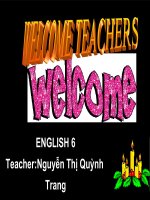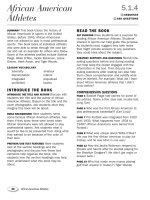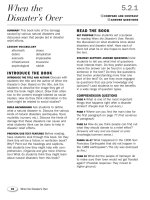- Trang chủ >>
- Mầm non - Tiểu học >>
- Lớp 5
5 4 5 what makes great athletes (social studies) TG
Bạn đang xem bản rút gọn của tài liệu. Xem và tải ngay bản đầy đủ của tài liệu tại đây (117.65 KB, 4 trang )
What Makes
Great Athletes
This book discusses what it takes to
be a great athlete. It tells about the demands
of training and competing that athletes have to
endure to prepare for a major competition. It
also highlights various notable athletes, such
as Jim Thorpe and Babe Didrikson Zaharias.
SUMMARY
LESSON VOCABULARY
archaeologists
Colosseum
endurance
mastery
rigorous
artifacts
coordination
esteem
persistence
INTRODUCE THE BOOK
Discuss with
students the title and the author of What
Makes Great Athletes. Based on the cover
photograph, ask students what kind of information they think this book will provide. Have
students decide if this book is a fiction or a
nonfiction book. Then ask them to name other
books they have read in this genre.
INTRODUCE THE TITLE AND AUTHOR
5.4.5
DRAW CONCLUSIONS
VISUALIZE
READ THE BOOK
Have students set a purpose for
reading What Makes Great Athletes. Students’
interest in sports competitions should guide
this purpose. Suggest that students think
about how we can achieve many things if we
work really hard.
SET PURPOSE
As students
read about outstanding individuals like Babe
Didrikson Zaharias, visualizing gives them a
chance to imagine how a person can become
great at something if he or she has determination and dedication to a goal. Ask students
to imagine what it would be like to be an
award-winning Olympic athlete.
STRATEGY SUPPORT: VISUALIZE
COMPREHENSION QUESTIONS
About how many years ago did the first
Olympic games occur? (2,800)
PAGE 6
What conclusion can you draw about
what the Ancient Greeks thought about athletes? (They valued them.)
PAGE 8
BUILD BACKGROUND
Ask students what sports
they like to play or if they are on a sports team.
Generate a discussion about what they think
makes a good athlete. Prompt them to think of
qualities like practice and determination.
What details helped you come to your
conclusion in the question above? (They gave
winning athletes large amounts of money, free
meals, decorated jars, and even built statues
of them.)
As students preview the book, the action shots of the athletes
will probably attract their attention. Ask them
to read the captions that go with the photographs to give the photographs more meaning.
Have them look at the photographs on page 7
and ask them how they think these images will
help them better understand the text.
How many miles would Jim Thorpe run
to get home from school? (20 miles)
PREVIEW/USE TEXT FEATURES
88
PAGE 8
PAGE 13
What made Babe Didrikson Zaharias
such a good athlete? (She focused on her
dream and she was strong both mentally
and physically.)
PAGE 15
What Makes Great Athletes
16924_LRD_TG_088-089 88
10/21/05 10:32:23 AM
REVISIT THE BOOK
READER RESPONSE
1. Responses will vary.
2. Responses will vary.
3. spectacular; energy; hesitating; hesitate;
marvel; accurate; honorable
4. Responses will vary but may include references to how athletes were treated then
and now and the emphasis on running in
ancient times and on team sports in modern times.
EXTEND UNDERSTANDING As students look at the
photographs, ask them why they like certain
ones. Ask them if the photographs help them
imagine what athletes go through to compete.
Draw their attention to the photographs of
athletes in action, especially on pages 4 and 5.
Ask students to discuss with a partner what
qualities make a good athlete.
RESPONSE OPTIONS
Ask students to imagine they have
to prepare for a major competition. Have them
make a daily training and meal schedule to
help them train for the event.
WRITING
SOCIAL STUDIES
CONNECTION
Students can learn
more about how athletes
train by researching them on the
Internet or at the library.
Skill Work
TEACH/REVIEW VOCABULARY
Divide students into small groups. Have
each group compete to make new words
from the vocabulary words by removing the
suffixes or adding new ones. Have groups
add up their new words and share their
words with the class.
Have students write each vocabulary
word on a separate index card. Then have
them sort the words into words with suffixes.
Finally, ask them to write the root word of
each word, using a dictionary if necessary.
TARGET SKILL AND STRATEGY
DRAW CONCLUSIONS Remind students that
a conclusion is a sensible decision reached
after thinking about details or facts in what
is read. As they read, have students draw
conclusions about what qualities a good athlete possesses, showing them by creating a
graphic organizer.
Remind students that to
visualize is to create a picture in the mind.
As students read, suggest that they visualize
what it would be like to be a great athlete
in their favorite sport.
VISUALIZE
ADDITIONAL SKILL INSTRUCTION
SEQUENCE Remind students that sequence
refers to the order of events in both a fiction
and nonfiction text. Sequence can also refer
to the steps in a process. Ask students to
read the following sentences from page 15
about the life of Babe Didrikson Zaharias.
Then have them put the sentences in
sequential order.
1. After her career as a track and field
champion, she became a professional
golfer.
2. By the time she was in her teens, she
already knew she wanted to be the
greatest athlete ever.
3. She … easily won the javelin and the
80-meter hurdles events at the Olympics.
What Makes Great Athletes
16924_LRD_TG_088-089 89
89
10/21/05 10:32:24 AM
Name
Great Athletes
Draw Conclusions
A conclusion is a sensible decision reached after thinking about details as facts in what is read.
Directions Read the following paragraph. Then answer the questions.
M
uch of our interest in sports and athletes comes from our knowledge of sporting events
in ancient Greece. The first Olympics were held at least 2,800 years ago, and scholars
believe that such games were probably held before then. The games were held at Olympia, a
center of religious ceremonies, in honor of Zeus, the most powerful of the Greek gods. Those
early games were festivals that combined races with religious observances.
1. Why did the early Olympics combine races with religious observances?
2. Why did the Greeks think the Olympics would honor Zeus?
3. Why does our interest today come from sporting events in ancient Greece?
5. Do you wish that you could have ran in the first Olympics? Why?
© Pearson Education 5
4. Do you believe that the first Olympics were held before 2,800 years ago?
90
16924_LRD_TG_090_091 1
10/21/05 10:33:00 AM
Great Athletes
Name
Vocabulary
Directions Write the vocabulary word that best matches each definition from the box.
Check the Words You Know
archaeologists
Colosseum
endurance
mastery
rigorous
artifacts
coordination
esteem
persistence
1. large building where people watched events in ancient Rome
2. not giving up
3. great knowledge of something
4. items made for a special use
5. the strength to withstand hard work
6. to regard favorably or admirably
© Pearson Education 5
7. those who study ancient people and civilizations
8. working together
9. demanding
91
16924_LRD_TG_090_091 2
3/20/06 8:47:49 AM









